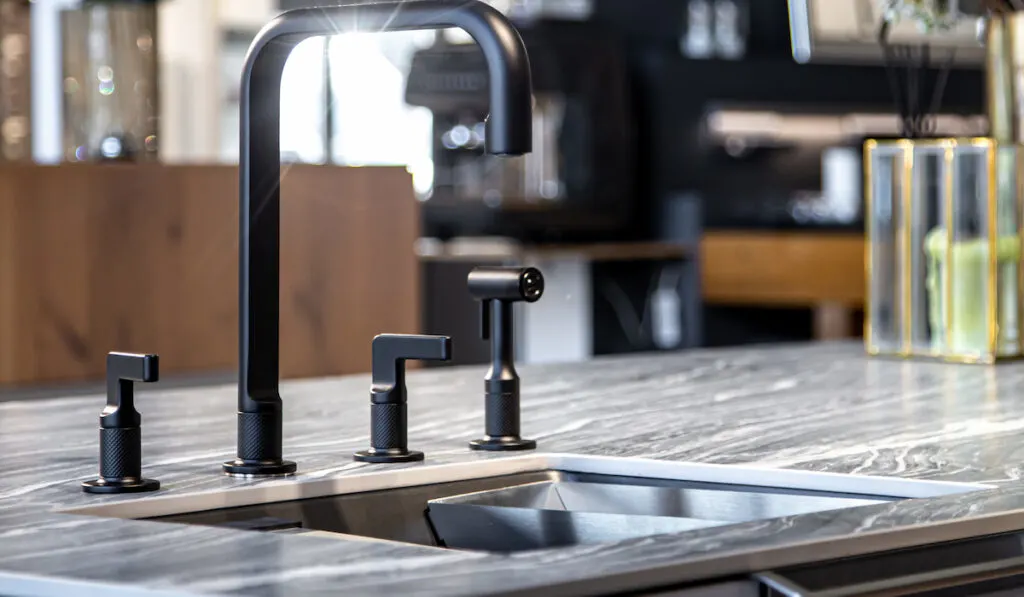Farmhouse sinks are something I have been looking into more and more. I just love the style and design but my concern is, can they be used with a laminate countertop? I decided to find out.
Can a farmhouse sink be used with a laminate countertop? Top-mount farmhouse sinks can be used on laminate countertops. While it is possible to use an under-mount sink with laminate, this is not recommended because water can seep into the particle board core and cause issues.
When you are looking for farmhouse sinks, you’ll find lots of designs but most will be under-mount. This type of countertop gives the more traditional farmhouse look most people are searching for.
If you are looking for some awesome top-mount options, check out the 7 Top Mount Farmhouse Sink Options I compiled.
There are some other great factors you should consider when purchasing a farmhouse sink.
Table of Contents
Installing a Farmhouse Sink on Laminate Counters
If you are installing a farmhouse sink on existing laminate counters, your best option is to choose a sink that is best suited for a retrofit installation. I researched many different options and the best ones I could find are the Kohler Vault apron front kitchen sinks (and I’m not sponsored by Kohler).
If you are doing a retrofit installation on existing laminate counters, you’ll want to thoroughly read through the installation instructions that come with your sink. These will have all of the measurements and mounting details needed specific to the model you purchased.
Basic Steps for Installing a Farmhouse Sink on Laminate Counters
- Remove existing sink and faucet.
- Measure countertop and mark new cut lines where needed.
- Carefully cut existing countertop along cut lines.
- Dry fit sink to ensure cuts were accurate
- Measure and apply support rails.
- Apply Silicone around countertop cutout.
- Lower sink and slide into place.
- Remove excess sealant.
- Install any additional mounting hardware.
- Apply additional sealant to outside of sink per directions.
- Install plumbing.
Kohler has a great video explaining the installation process from start to finish for their apron sink model. Regardless of what farmhouse sink brand you purchase, this is an excellent look at how to install a top-mount sink onto existing laminate countertops.
There are a variety of different materials to consider when looking at farmhouse sinks. Deciding on one is a difficult task when you are installing new countertops at the same time. If you are installing on existing laminate though, you may be stuck with stainless steel. Let’s look at some material options you could consider.
The Common Materials Used for Farmhouse Sinks
The farmhouse sink has a very distinct look that can be made extremely unique depending on the type of material chosen for the sink.
If you are looking to get the farmhouse look and feel without breaking the bank, the most economical farmhouse sink material is typically going to be stainless steel.
That being said, each material type has its own merits. Let’s look at three common materials used in farmhouse sinks.

Fireclay Farmhouse Sinks
A fireclay sink is made of molded ceramic that has been kiln dried and then coated with porcelain enamel and baked. The result is a smooth, traditional looking finish. The most common color is white although custom colors are possible.
While cast iron sinks are also often coated in porcelain enamel, a fireclay sink is going to be easier to maintain. The clay inner base means that the sink will not rust if the porcelain enamel chips.
Although I could find pictures of top-mount porcelain sinks, I couldn’t actually find a source for them (at least not online). So, while it seems they do exist, that must mean they are custom order or hard to source.
Copper Farmhouse Sinks
Copper sinks in general have a gorgeous, rustic feel to them. They are immediately noticeable in any kitchen and will definitely be the center of attention.
Copper sinks do, however, require special treatment. While copper is stain-resistant and rust-resistant, only mild cleansers or special copper cleaners should be used to avoid damaging the finish.
If you want a very customized sink design, copper is a great option because of its malleability. A skilled artisan can easily shape the apron of your farmhouse sink with any pattern you desire. Intricate designs, symbols, patterns and even nature scenes can be added to make your sink one of a kind.
Stainless Steel Farmhouse Sinks
One of the most attractive things I found about the stainless steel sink is the affordability. Of the materials listed, it is definitely the most economically priced.
The big con with the stainless steel sink is that it doesn’t really give that true, traditional farmhouse feel. If you are looking for a material that is easy to clean, heat resistant and matches your appliances, the stainless steel farmhouse sink is a great option.
Even though stainless steel is inexpensive, there are still some really awesome design options to choose from. They come in single and double bowl. This, of course, can be a huge decision point as well.

Single Bowl or Double Bowl Farmhouse Sink?
Now that we know we can install a farmhouse sink on laminate countertops, and that stainless is the most easily attainable option, is a single bowl or double bowl best?
This is really a dilemma for me. I have always had a double bowl sink and what I love about that is being able to put dirty dishes in one side and have a “clean” side to wash dishes or rinse food. That reasoning, though, revolves around the fact that I don’t have a dishwasher.
The Case for a Single Bowl Sink
I found that there are definitely some pros and cons to a single bowl sink. The biggest pro for me is the larger space to be able to clean or soak baking pans. I have been filling them with water and leaving them on the counter so this would definitely be an improvement!
Pros:
- Larger area can accommodate bigger pans for soaking
- Easier to cleanup only one space vs. two
Cons
- Requires a larger amount of water to fill sink if you need to soak dishes (or wash the baby)
- Can’t separate tasks, there’s no “clean” side if dirty dishes are piled in there.
The Case for a Double Bowl Sink
Double bowl sinks are what I am used to but that doesn’t mean they are necessarily the right answer. I also found some good pros and cons for the double bowl farmhouse sink.
Pros
- Easy to separate tasks. Fill one side to soak dishes and use the other to rinse fruit, drain pasta, etc.
- Handles a garbage disposal more easily. Stack your dirty dishes on one side and you’ll leave the garbage disposal available for use on the other.
Cons
- Harder to deal with cleaning large pots.
- More surface area may not be as quick to clean.
I think this decision really comes down to personal preference and I’ll be honest, even though I am used to a double bowl sink, I am very curious to try a single bowl.
Related Questions
Can under-mount sinks be used with laminate countertops? It is not recommended to use under-mount sinks with laminate. The laminate is a thin coating typically applied over a particle board core. Using an under-mount sink would expose the core and could result in water damage to the countertops if the core absorbs water and moisture from the sink.
Are farmhouse sinks worth it? If you are looking to add a larger sink with an awesome farmhouse feel, then a farmhouse sink is definitely worth the investment. The sturdy materials available will help to ensure that the sink lasts you and your family a lifetime.
Are there any farmhouse sink drawbacks? Farmhouse sinks can be very heavy, especially if you go with cast iron or stone. This may lead to dishes being broken more frequently. In addition, porcelain enamel coated sinks may scratch while stainless steel sinks often show water spots. Most of these drawbacks are easily overcome with care and maintenance.
